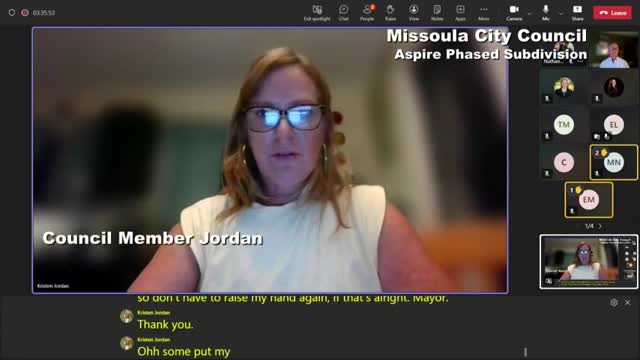City Council Votes Against Controversial Housing Development Plan
August 26, 2024 | Missoula, Missoula County, Montana
This article was created by AI summarizing key points discussed. AI makes mistakes, so for full details and context, please refer to the video of the full meeting. Please report any errors so we can fix them. Report an error »

In a recent city council meeting, significant concerns were raised regarding a proposed residential development in East Missoula, which has sparked a heated debate among council members and local residents. The proposal, which includes a substantial number of variances, has been met with opposition from some council members who argue that it does not align with the city's growth policy and fails to address critical community needs.
Councilor Jordan expressed strong reservations about the development, citing the numerous variances requested, environmental concerns, and the potential for increased traffic in an area predominantly composed of single-family homes. He emphasized that the current housing crisis in Missoula is exacerbated by developments that prioritize density over affordability, leaving lower-income neighborhoods vulnerable to rapid changes that do not benefit existing residents.
City staff defended the proposal, highlighting that it falls within the city's designated annexation area and aligns with the growth policy aimed at increasing housing supply. They argued that the development would provide necessary infrastructure and services, including access to city water and sewer systems, and would help meet the demand for housing in a desirable area.
However, the planning board's previous concerns about the project were echoed by several council members, who noted the political implications of the development's location and the potential impact on local residents. Councilor Campbell raised questions about the nature of the variances requested, suggesting that many were based on convenience rather than genuine hardship, which could undermine the integrity of the approval process.
As discussions continued, the council grappled with balancing the need for new housing against the preservation of community character and the well-being of existing residents. The outcome of the vote remains uncertain, as council members weigh the implications of the proposed development on the future of East Missoula and its neighborhoods.
Councilor Jordan expressed strong reservations about the development, citing the numerous variances requested, environmental concerns, and the potential for increased traffic in an area predominantly composed of single-family homes. He emphasized that the current housing crisis in Missoula is exacerbated by developments that prioritize density over affordability, leaving lower-income neighborhoods vulnerable to rapid changes that do not benefit existing residents.
City staff defended the proposal, highlighting that it falls within the city's designated annexation area and aligns with the growth policy aimed at increasing housing supply. They argued that the development would provide necessary infrastructure and services, including access to city water and sewer systems, and would help meet the demand for housing in a desirable area.
However, the planning board's previous concerns about the project were echoed by several council members, who noted the political implications of the development's location and the potential impact on local residents. Councilor Campbell raised questions about the nature of the variances requested, suggesting that many were based on convenience rather than genuine hardship, which could undermine the integrity of the approval process.
As discussions continued, the council grappled with balancing the need for new housing against the preservation of community character and the well-being of existing residents. The outcome of the vote remains uncertain, as council members weigh the implications of the proposed development on the future of East Missoula and its neighborhoods.
View full meeting
This article is based on a recent meeting—watch the full video and explore the complete transcript for deeper insights into the discussion.
View full meeting
